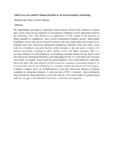Please use this identifier to cite or link to this item:
https://cris.library.msu.ac.zw//handle/11408/3519Full metadata record
| DC Field | Value | Language |
|---|---|---|
| dc.contributor.author | Shoko, Moreblessings | - |
| dc.contributor.author | Maunga, Pardon | - |
| dc.date.accessioned | 2019-04-11T11:31:31Z | - |
| dc.date.available | 2019-04-11T11:31:31Z | - |
| dc.date.issued | 2017 | - |
| dc.identifier.uri | http://dx.doi.org/10.4314/sajg.v6i3.6 | - |
| dc.identifier.uri | http://hdl.handle.net/11408/3519 | - |
| dc.description.abstract | The opportunities provided by Unmanned Aerial Systems (UAS) in the collection of spatial data, create a need for geo-engineers to continuously contribute to novel application areas for the technology. This study looked at the application of UAS imagery in the detection of illegal migrants at unauthorised areas around international boundary regions. International boundaries can be made up of connected sections with crisp (man-made) and at times fuzzy (natural) areas that collectively distinguish neighboring territories from each other. Areas with fuzzy boundaries can easily become conflict hotspots as they are prone to attract cross national movements, resulting in crime, military action and illegal migration. This is a growing challenge in world economies. In developing countries, human security details often man and patrol international boundary areas depending heavily on visual detection to monitor cross border movement. Visual patrol has great limitations and is often ineffective especially during the night. The main objective of this research is to propose a conceptual design for an early detection alert system suitable for use at border controls that is based on UAS imagery. It utilises a shadow index on an RGB dataset to test and validate the detection of human candidates in designated hotspots. A detection rate of 92% is reported. Alert information derived from the image detection is to be sent directly to the smart phones of ground patrol staff who navigate to the identified location for verification and mitigati | en_US |
| dc.language.iso | en | en_US |
| dc.publisher | South African Journal of Geomatics | en_US |
| dc.relation.ispartofseries | South African Journal of Geomatics;Vol. 6, No. 3: p. 349-362 | - |
| dc.subject | International boundary | en_US |
| dc.subject | Drone | en_US |
| dc.subject | Humanitarian | en_US |
| dc.title | ‘Sold by our own shadow’: human detection in uas based boundary monitoring | en_US |
| dc.type | Article | en_US |
| item.openairetype | Article | - |
| item.fulltext | With Fulltext | - |
| item.languageiso639-1 | en | - |
| item.openairecristype | http://purl.org/coar/resource_type/c_18cf | - |
| item.grantfulltext | open | - |
| item.cerifentitytype | Publications | - |
| Appears in Collections: | Research Papers | |
Files in This Item:
| File | Description | Size | Format | |
|---|---|---|---|---|
| Sold by our own shadow.pdf | Abstract | 83.58 kB | Adobe PDF |  View/Open |
Items in MSUIR are protected by copyright, with all rights reserved, unless otherwise indicated.



